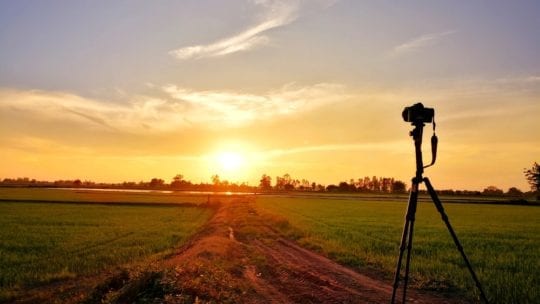
As the presidential primaries loom right around the corner, and the Iowa caucuses place an emphasis on political support from the American heartland, we'll surely be hearing much more from candidates hoping to appeal to our country's farmers. But presidential hopefuls would do well to remember that even the most soil-dusted hands in America can feel a great change affecting their industry.
Yesterday, Bloomberg cited a 2018 Pew Research Center study that found YouTube to be the most popular online platform among those in rural America—at 59 percent—drawing more eyes than Facebook, Instagram, Twitter and more. Social media manager Keith Good, who works for Farmdoc project at the University of Illinois told Bloomberg, “Farm organizations and commodity groups have encouraged producers to be part of the conversation on social media.”
The Bloomberg piece also profiles several farmers who are also YouTube creators—Zach Johnson (300,000 subscribers and approximately 50 million views), Suzanne Cook and Josh Draper—pushing content out to the niche demographics for whom their stories and specific challenges resonate on a personal level.
"The distance from field to fork continues to stretch wider with less than 2 percent of the U.S. population involved with farming," says Caryn Caratelli, SVP G&S Business Communications and a top PR pro in the agricultural sector. "As a result, many farmers and producers now serve as 'agvocates' on social media, educating the public on the inner workings of modern farms."
"Not often recognized as such, agribusiness is indeed a tech-first industry, continues Caratelli. "Whether it’s analyzing sensor- or drone-captured data to run farms more efficiently or posting YouTube videos to educate and show their passion for the land, farmers and ranchers are both digitally savvy and adept at leveraging social media to share their stories."
This trend of farmers sharing their practices on YouTube comes bundled with some strong takeaways for communicators about why how-to, service-oriented content always does well and why YouTube is a more powerful platform for engagement than many PR Pros realize.
YouTube's "Hub-Hero-Help" model lends itself well to agricultural content
During last week's PRNEWS Digital Boot Camp, Leah Eder and Tod Plotkin of Green Buzz Agency reminded attendees that YouTube is a powerful search engine, and one capable of tracking more than just views should content producers focus on the appropriate KPIs.
Moreover, the content that performs best on YouTube follows its "Hub-Hero-Help" content model. First, a content "hub' targeted at demographics already interested in your brand, products, or in the case of our farmers, agricultural methods. Regularly scheduled, series-type content always performs well, which the chronological routine of a successful farm lends itself well to. Building a hub also develops loyalty with your viewers.
The "hero" piece of content refers to the fact that a content producer makes themselves an expert authority, or "hero," by developing loyalty and maintaining an audience with value. This could be a larger mission statement for a farm, or a local partnership with someone who shares the farm's values. Producing two or three of these a year would be plenty.
Finally, the "help" content capitalizes on the inquisitive nature of a channel's niche audience with content that brings a direct value or fulfills a direct need. Eder and Plotkin suggested ten of these a year, tops.
Evergreen, how-to content thrives on YouTube
Condé Nast's VP of Audience Development, John Shehata, also gifted our bootcamp with a look at his strategy for improving content performance across the publisher's vast portfolio of brands by focusing on evergreen content. Evergreen content is so named because it does not tie directly to a newsy or time-stamped peg, and hence, has a much longer shelf-life than hard news pieces. In a nod to the term "evergreen," Shehata named his initiative "Pinetree."
Though farms themselves are seldom perennial, or able to thrive year-round, the content that farmers produce on YouTube can provide practical, educational lessons no matter the time of year. Lessons on how to properly maitenance a tractor or adjust your soil pH do not depend on what's trending, and as such, they provide much greater value to the right viewer.
The lesson for communicators here is that brand content should satisfy a similar need—providing resources specific to your industry beyond mere self-promotion. A video educating your customers with some little-known facts is an easy way for your investment bank to sound like experts, while a step-by-step process video can empower them to become more autonomous when satisfying their needs.
This needn't render your products or services obsolete, either—by following the aforementioned "Hub-Hero-Help" model, your brand remains the helper, the hero, and the go-to expert that customers will feel empowered to trust with their needs in the future.
